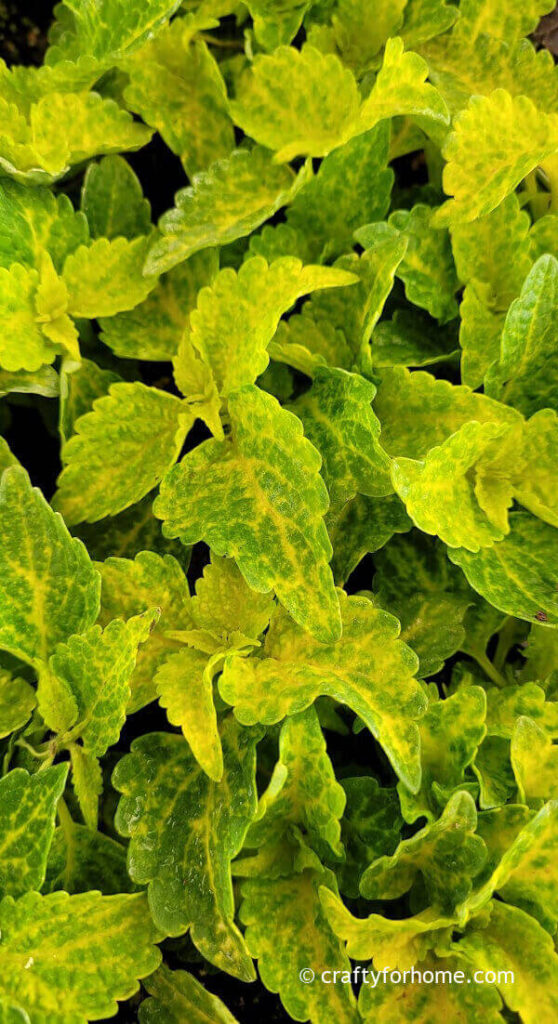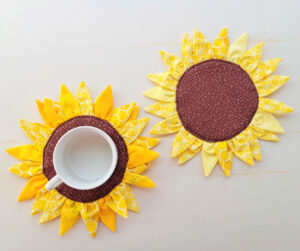As a low care plant and beginner-friendly, the coleus flower is easy to grow throughout the garden or creates curb appeal for the front of the house.
Tips For Growing Coleus Plant
Coleus flowers grow primarily for the colourful foliage. Therefore, even though coleus has a flower spire resembling mint’s blooms, it is better to snip it off and make the coleus plants bigger.
As an Amazon Associate I earn from qualifying purchases. This post may contain affiliate links. Please see the Disclosure Policy for details.

Coleus plant is part of mint family include basil, marjoram, sage, lavender, oregano, anise hyssop, bee balm. It shows by the square shape stem. However, coleus grows for its ornamental value of colourful and pattern foliage, unlike its cousins as culinary herbs.
It comes with colour and shape varieties, from the chartreuse lacy-shaped foliage to the bicolor variegated oval-shaped ones. You will find yourself keep deciding which coleus you want to grow. All of them are beautiful, easy to grow, and beginner-friendly.
Coleus Growing Condition
The most recognizable of coleus flowers characteristic is the variegated or maroon foliage. The showy colour leaves will brighten up any garden space.
Coleus plant is a hardy perennial for zone 10-11 and grows as an annual flower in other zones. Coleus grows better in the part shade with protection.
The soil condition should be moist and well-drained as the coleus has a fibrous root that likes to keep it well watered. If you have compact clay soil, adding organic matter like compost and aged manure will improve the soil condition.
Can You Grow Coleus In Full Sun
Some coleus varieties grow vibrant foliage in the full sun with protection. However, most coleus plants will only appreciate the shaded area.

With humidity, coleus can grow in the full sun in the warmer zone (zone 10-11). However, if your garden is in the other zones (colder), make sure the plant gets the full morning sun and afternoon shade.
In addition, keep the soil moist and well-watered. Coleus foliage tends to wilt and wither if the soil is dry.
Growing Coleus In A Container
Grow coleus in a container if you have limited space in the garden bed. You get the advantage of it by placing the container anywhere you prefer.

If your garden is mostly sunny, you can place the coleus in the part shade of your yard, the porch, by the front door, or under the tree.
Pair the coleus flowers with some trailing plants like petunia, calibrachoa, lantana, creeping charlie, lantana, or sweet potato vine. Then, pair it with zinnia, ornamental grass, celosia, and heliotrope for the upright growing habit.
Grow coleus with hosta, impatiens, corral bell, fern, ligularia, and begonia for the shaded area. Ultimately, grow coleus on its own as a single potted plant. The bushy growing habit fills up the container quickly.
You can also colour-code all plants for the monochrome container garden. For example, pair the chartreuse coleus with the chartreuse hosta and corral bell or the maroon coleus with the maroon corral bell.
How To Water Coleus Plants
Water coleus plants daily to keep the soil moist. Watering time also depends on the temperature during the growing season.
For example, if it is a hot and dry sunny day, you might need to water it often. On the opposite, if it is a damp and rainy day, you might water it less.
Always check the soil surface. If it dries on approximately one inch deep, it is time to water the coleus plant. Coleus grows in a container might need to water it often as it tends to dry out quickly.
Best Fertilizer For Coleus
Since it grows mainly for foliage, use fish emulsion or compost tea to fertilize coleus every 1-2 weeks.
Adding compost, well-aged manure, or worm casting to the soil mix helps to act as a slow-release fertilizer.
How To Make Coleus Bushy
Since the easiest way to grow coleus is from plant starter or stem cutting, they seem small initially. However, once you transplant the coleus plant in a larger container or straight into the garden bed, coleus plants will grow bushier quickly.

The other way to make coleus bushy is by pinching the flower bud to keep the plant energy growing foliage. Also, cut the plant stem close to the leaf regularly. Later on, it will grow two new branches.
While you want to remove the tomato plant sucker, keep the coleus plant sucker growing instead, thus making the coleus bushier.
Keep the plant cutting when you pinched off the coleus plant stem. You can make more coleus plants by rooting the cutting.
Overwintering Coleus Plants
The advantage of growing coleus in a container is that you can bring it indoors when the growing season ends. Coleus from the garden bed also can be overwintered indoors by digging it and transplanting it to a container.

Alternatively, take coleus cuttings and make new house plants. This way, you will have multiple coleus varieties and won’t take too much space indoors.
Before cold weather comes, dig a healthy coleus plant from the garden bed and get the root as much as possible. Then, transplant it to a container with new potting soil.
Inspect the plant for bugs and pests such as mealy bugs, aphids, spider mites, or slugs. Remove any wilted or old foliage. Use this method to remove bugs and prepare them to grow indoors.

Since coleus is a perennial in the warmer zone, coleus plants can grow as a houseplant. The issue might be the light requirement and humidity.
Put the coleus by the window apart from the cold draft. During winter, I usually put the container on the floor about one foot from the south-facing window. This spot typically gives coleus about 4-5 hours of sunshine.
Because the air tends to dry out indoors, keeping the plant well watered and occasional fine mist on foliage helps with the humidity that coleus need.
Grow coleus as an easy-to-grow plant and create curb appeal. #plantingcoleus #coleus #curbappeal Share on XHere are more beginner-friendly plants to grow in your garden.
- Easy To Grow Perennial From Seed
- Easy To Grow Annual Flowers From Seed
- Easy To Grow Herbs From Seed
- Easy To Grow Vegetables From Seed
- Vegetables To Grow In Early Spring
- Late Summer Blooming Perennial
- Frost Tolerant Annual Flowers
How To Grow Coleus For Colorful Foliage







Leave a Reply